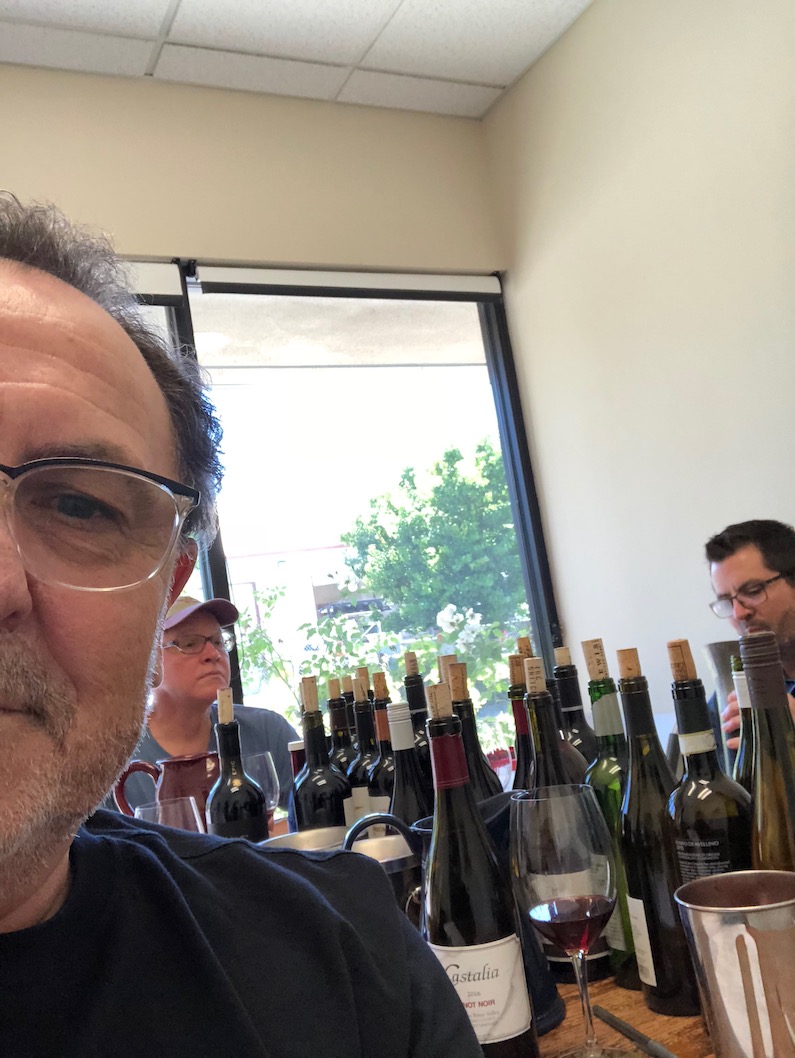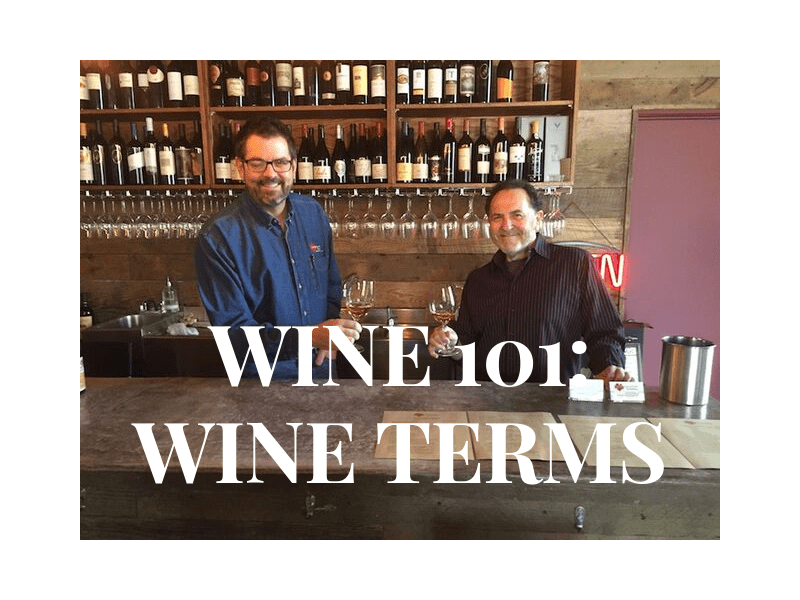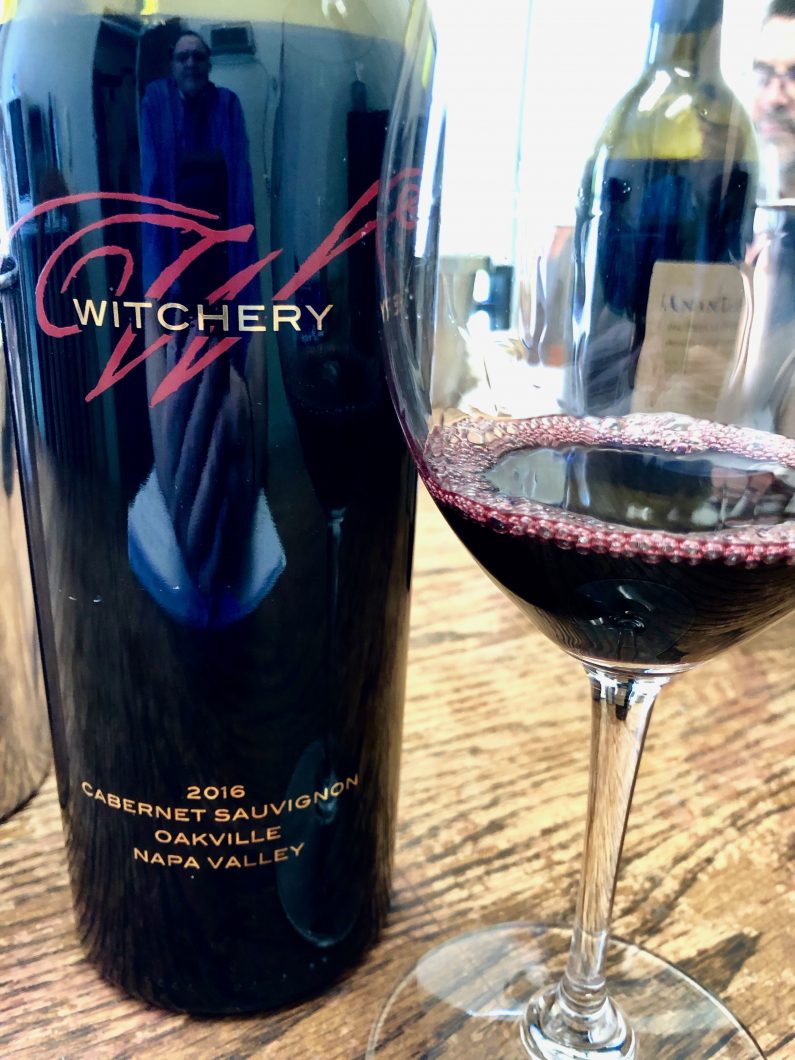Occasionally there will be a customer that will ask me “What did you mean by ‘such and such’ in your notes?” So I thought it would be a helpful to go over some terms that frequently appear in my offerings.
Knowing what is meant by these terms will possibly add another layer of enjoyment to your wine experience, especially in a group setting, and hopefully will also help you in your wine evaluations.
This list will focus more on texture and structure of the tasting experience, and not go into flavors extensively as they are subjective, to say the least. For example where I taste cherry, you may taste raspberry, etc.

A typical tasting begins at the Wine Country Connection weekly tasting.
“We taste bad wines so you don’t have to.”
We taste some really great ones too!
WINE TERMS
LEGS/TEARS: Legs (or tears) refer to the streams that linger on the inner sides of your glass after you stop swirling. The longer the legs linger, the more structured your wine will be.
COLOR: The first thing to evaluate after pouring a wine into the glass is the color. Hold the glass against a light background such as a piece of plain white paper to asses the color and clarity. Color is a key factor in determining a wine’s age and quality. White wines grow darker in color with age, whereas red wines turn brownish orange, especially around the edges. The wine should be vibrant and clean, but if the wine is murky, it should raise some red flags.
AROMAS/NOSE/BOUQUET: Sticking your nose in the glass will give you a good glimpse into how the wine will taste and if you’re like it. If you like the smell, there’s a good chance you’ll like to taste. I like to initially pick out 3 dominant characteristics that immediately come to mind. For example, a Cabernet may offer aromas of red berry fruits, dark chocolate and oak; a Chardonnay may exhibit aromas of gpear, lemon meringue, and vanilla.
Occasionally you my encounter aromas that are more “savory” than “sweet,” such as ‘forest floor’, leather, or ‘barnyard’. These aren’t necessary bad as they can make appearances in wines from the southern Rhone Valley, domestic Syrahs and blends. But they should not be the dominant aroma with no fruit characteristics present.
If the wine smells like damp, soggy, wet or rotten cardboard, the wine is probably Corked. Cork taint dulls the fruit in a wine, renders it lackluster and cuts the finish. Cork taint is caused by the presence of TCA (2,4,6 – Trichloroanisole), which is not harmful to humans, but can be very unpleasant to smell or taste. Sometimes the corked smell is barely noticeable, and sometimes you can identify it as soon as the cork is pulled. It just depends on your sensitivity to it (aka you cork taste threshold).
TASTE/SIPPY SIP: This is where it gets fun. Take a small sip and swish it around in your mouth, taking in a little air to aerate. This will help open up more flavors and textures. Then swallow, or spit, and think about how the wine felt on your palate. Did the flavors coincide with the aromas? Were other flavors and nuances apparent? Did the wine feel heavy and engulfed your palate, or was it light and elegant (structure/texture)?
FINISH: Refers to the aftertaste after swallowing and how long it lasts. The longer the better.
OTHER OFTEN USED TERMS
TANNINS: Mostly prevalent in red wines, but can also be found in white wines, tannins are phenolic compounds that exist primarily in the skins, stems and pits. Occasionally winemakers will utilize whole cluster fermentation where the stems are included in the fermentation process, adding an earthy component to the wine. Tannins can also be derived from oak barrels. Tannins are astringent and provide structure to a wine. Over time with aging the tannins will die off, the fruit will come forward and the wine will become more seamless.
BODY: This is the impression of weight on your palate as you hold the wine in your mouth. body is similar to structure, and light, medium and full bodied are typical descriptors. None is better than the other. It just depends on your personal taste.
BALANCE: Probably THE MOST IMPORTANT characteristic in a wine. This refers to a wine where all the components are in harmony and there is not one component that dominates the others. Typically BALANCE refers to the relationship between fruit, tannins, alcohol, and acidity. You may notice each of these components individually, but as long as there’s not one component overpowering the others, a wine is said to be in balance.
However, younger wines, especially big red wines like Cabernet Sauvignon and Cabernet-based Blends may exhibit more tannins in their youth, which is why many people like to lay them down for a number of years and let them meld into a harmonious wine.
RIPENESS: Another reference to how the wine tastes. If a wine is said to be “overripe,” it suggests raisins, compote, prunes and other dried fruits. Although not ideal in still wines, it may indicate a “hot vintage,” or grapes that were left hanging extra long on the vine, allowing more sugar to accumulate, and thereby increasing the alcohol level. Long “hang time” and very ripe fruited wines were very popular in the 1990s. I recall having a tee shirt from Turley Cellars that had “17.5% alc” emblazoned on the sleeve. They were very proud of that. Today things have come back into balance with alcohol levels much lower than that, typically around 14-15% for Cabernet Sauvignon and around 14-16% for Zinfandel.
ACIDITY/MINERALITY: A naturally occurring component component of every wine, acidity provides a level of perceived sharpness or tartness. This is a key element to a wine’s longevity and a leading determinant of a wine’s balance. A wine with notable acidity may sometimes be referred to a “racy,” which is refreshing and palate cleansing, typically leaving you craving another sip.
SWEET VS SAVORY?: Customers often remark to me that they don’t like ‘sweet’ wines. What I understand that to mean is they prefer DRY wines. Sweet wines are typically desert wines. Most of the ‘still wines’ are made in a dry style, where the natural sugars in the fruit are converted into alcohol during the fermentation process. We prefer to describe the wines as ‘fruity’ or ‘fruit-driven,’ which basically indicates the presence of fruit components nuances; for example, black cherry, cassis, currants in red wines, or green apple, pear, citrus in white wines. Sweet, or desert wines have higher levels of residual sugar that are left over after the fermentation process.
SAVORY: Some people think this is a negative descriptor of wines, but I don’t necessarily agree. Aromas and flavors of dried herbs like sage, thyme and rosemary are common descriptors of wines from Southern France (Rhone Valley, Gigondas, etc.), often described as “garrigue.” However, if a wine tastes “green,” it indicates underripe grapes, and is usually thin and astringent.
FEATURED WINE
You know a brand has something extra special when just about everybody that tries it becomes a devoted fan and collects each subsequent vintage.
WITCHERY
2016 OAKVILLE
CABERNET SAUVIGNON
NAPA VALLEY
It’s almost like one taste of Witchery casts a powerful spell with its rich and hedonistic flavors, and wine lovers really don’t stand a chance.
It’s the wines spellbinding style that’s filled with chillingly rich, extracted flavors that casts you on a witch-hunt for more once you taste it.
Witchery’s flagship Oakville bottling screams top-level Napa Cabernet Sauvignon, and the wine originates from a vineyard that sits directly South of Opus One on Highway 29.
The vineyard is in a sweet spot of Oakville where the soils are sandy and gravelly with exceptional drainage that helps produce large root systems and healthy vines.
It’s rare to find a top-shelf Oakville Cab at $100, and this one tips the scales with groundbreaking levels of quality.
This 2016 Oakville is their best yet, and flaunts a dramatic perfume laced with intense brambleberry, dried violets, Baker’s chocolate and sweet camphor.
I you have tasted any of the previous vintages of Witchery, you know the level of quality this winery produces.
I highly recommend grabbing some of this 2016 Witchery Oakville Cabernet for your cellar before it disappears. Just six cauldrons, I mean barrels were produced.
WITCHERY
2016 OAKVILLE
CABERNET SAUVIGNON
NAPA VALLEY
Retails at: $110.00/btl
Member’s Price: $99.99/btl Click to Order
+ GROUND SHIPPING INCLUDED ON ANY 15, 750ML BOTTLES TO SOME STATES
Tasting Notes: “Some Cabernets are styled more elegantly with laser like precision, while others are monstrous, bold and powerfully inky. Somewhere in the middle lies the perfect balance of power & grace and I’ve found it in this wine. The Witchery Oakville Cabernet Sauvignon 2016 is a picture of balance with a nose that actually smells satiny with fresh black plums, crushed blueberries, sweet vanilla and delicate floral notes. The palate is lush and beautifully balanced with black cherry, red currants, ever so slightly dusty tannins and beautifully integrated toasty oak. The finish is long, penetrating and so mouth watering that it evokes a pavlovian response. It is absolutely beautiful now, but will age gracefully for a decade or more.”
96 Points, Kevin M. Vogt, Master Sommelier
NOTE: All wines offered for sale on this website are sold through our affiliate and fulfillment partner, Wine Country Connection.




